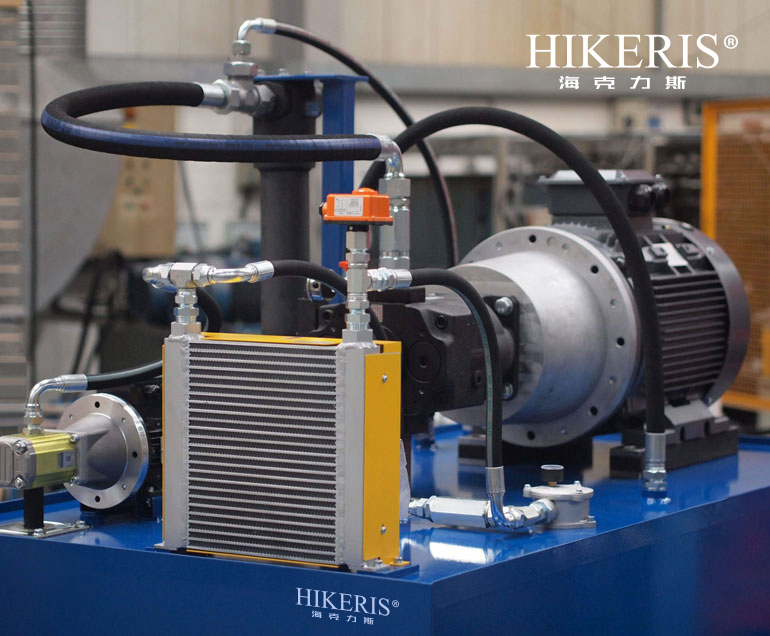With the exception of the reservoir, every component in a hydraulic system is a heat-generating device. The process of moving hydraulic fluid through a conductor from A to B results in pressure drop and, therefore, heat generation. Installing depth filters to control particle contamination also creates a pressure drop, which increases heat load. Pumps and motors leak internally, resulting still more heat-generating pressure drops. The charge pump on a hydrostatic transmission is 100% heat load. In open circuits, heat-generating orifices, throttles (in all their various forms), and hydrostats are installed to control direction, flow, and pressure—and loads are counterbalanced by installing hydraulic resistance.
Energy Contamination Affects Lubrication
Adequate lubrication of hydraulic components and efficient power transmission both depend on appropriate oil viscosity. If hydraulic fluid temperature is allowed to exceed that required to maintain viscosity at around 20 centiStokes (cSt), the likelihood of boundary lubrication—resulting in friction and wear—increases dramatically.
The temperature at which this point is reached depends on the fluid’s viscosity grade and its viscosity index (VI). The VI is a measure of an oil’s resistance to change in viscosity with a change in temperature. An oil with a high VI is often called a multi-grade oil. Multi-grade oils are often specified for equipment that must operate in cold. The high VI helps prevent the oil’s viscosity from increasing (thickening) at low temperatures. However, a high VI also helps prevent its viscosity from decreasing (thinning) at high temperatures.
he Exponential Effect of Energy Contamination
Regardless of viscosity limits, which are extremely important for proper lubrication and efficient operation, when it comes to oil, seal, and hose life, the top-end danger temperature is less of a moveable feast. According to Arrhenius's Law, for every 10°C (18°F) increase in temperature, the rate of reaction doubles. The chemical reactions we are concerned with concerning hydraulic oil life are oxidation (from the presence of air) and hydrolysis (from the presence of water). So the hotter the oil, the faster the rate of these reactions, and exponentially so.
The second involves intense local heating of the oil. Common causes of localized intense heat are:
collapse of entrained air bubbles,
micro-dieseling,
high watt-density tank heaters,
large and continuous pressure drops in the system—for example, oil passing over a relief valve—and,
arcing caused by electrostatic discharge. This process is sometimes referred to as thermal oxidative degradation.
Excessive Heat Damages More Than the Oil
Hydraulic oil is not the only thing affected by energy contamination. The elastomers used to make hydraulic seals and hoses are improving all the time. But oil temperatures above 82°C (180°F) accelerate the degradation of most of these polymers. In fact, according to seal manufacturer Parker Pradifa, operating temperatures 10°C (18°F) above recommended limits can reduce seal life by 80% or more.
Similarly, according to hose manufacturer Gates, exposing a hydraulic hose to an operating temperature 10°C (18°F) above its recommended maximum cuts its expected service life by 50%. This means a single, over-temperature event of significant magnitude can damage all the hoses and seals, “crack” the oil, and result in scuffing and wearing of lubricated surfaces.
Setting Temperature Limits
So what is the dangerous operating temperature number for hydraulic systems? For reasons already explained, to avoid compromising oil, hose, and seal life, I always work on a maximum of 85°C (185°F). However, to avoid compromising viscosity, lubrication, and system efficiency, a much lower temperature may have to be respected: from 85°C (185°F) down to around 50°C (122°F)—or perhaps lower, depending on the grade and type of oil being used, and by extension, the climatic conditions the machine operates in. Staying below these maximum temperature limits year-round will, in most applications, require that the machine’s hydraulic system uses an oil cooler—and in many cases, a big one.
HIKERIS OIL COOLER Models:
AF0510T-CA
AF1025T-CA
AL404T-CA
AL608T-CA
AH0608T-CA
AH1012T-CA
AH1215T-CA
AH1417T-CA
AH1470T-CA
AH1490T-CA
AH1680T-CA
AH1890T-CA
AH2431T-CA
AH3818T-CA
LOC-004
LOC-007
LOC-011
LOC-016
LOC-023
LOC-033
OR-60L
OR-100L
OR-150L
OR-250L
OR-350L
OR-600L
OR-800L
OR-1000L
OR-1200L
